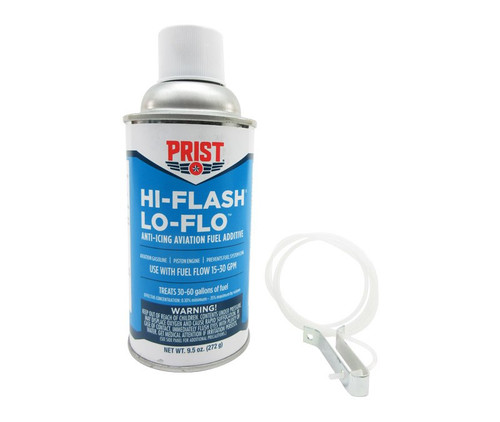i-Flash Hi- Flo vs. Hi-Flash Lo-Flo p>
hat's the Difference? p> The two products are identical in chemical formula. Hi-Flo additive simply means the can delivers the product at a rate compatible with a 40 to 55 gall per minute fuel nozzle rate. Lo-Flo additive can deliver the product at a rate wich is typical of avgas, which is 15 to 20 gallons per minute. Lo-Flo is also used in helicopters, which typically have to be fueled slowly.
afer and easier to handle than conventional anti-icing fuel additives. em>Prist Hi-Flash anti-icing aviation fuel additive was developed to meet the new demands of the aviation industry. Next generation Hi-Flash additive is less toxic, less volatile and much easier to use than conventional additives.
hy you should use a fuel additive p> All turbine aircraft fuels contain some dissolved water. It cannot be extracted because it does not exist as particulate water. When an aircraft rises to flight altitude, the fuel cools and its capacity to retain dissolved water is reduced. Some of the dissolved water separates out as discrete water that can form into ice crystals or remain as a supercooled liquid. When supercooled water strikes a tubing bend or a filter, it can freeze quickly and block a fuel line or filter. If suspended ice crystals are present, they can also block a filter. Prist Hi-Flash anti-icing aviation fuel additive controls icing in aircraft fuel by depressing the freezing point of water.
ontrolling Fuel System Icing p> Prist Hi-Flash additive has limited solubility in jet fuel, but is completely soluble in water. When dissolved water separates from the fuel, some amount of Prist Hi-Flash additive quickly leaves the fuel and preferentially dissolves in the water. This depresses the water's freezing point. As the fuel gets colder, and more water particles appear, more Prist Hi-Flash additive leaves the fuel and enters the water, and your aircraft's fuel lines stay clear.
ully Authorized p> Prist Hi-Flash anti-icing aviation fuel additive is authorized by the United States Armed Forces under Military Specification Mil-DTL-85470(B), and by the ASTM under Standard D4171 for use in civilian jet fuels as a fuel system icing inhibitor. As part of its ASTM approval process, the formulation of Prist Hi-Flash additive was reviewed and approved by turbine engine and turbine aircraft airframe manufacturers worldwide. Prist Hi-Flash additive is recommended for every refueling at a dosage rate of .10% minimum to .15% maximum by volume.
andling and Storage p> Prist Hi-Flash aviation fuel additive should be handled as a combustible liquid and stored away from direct sunlight and other sources of heat. The flammable limits of its vapor range from 1.2% to 22% in the air.
Prist Hi-Flash additive should be protected from contact with oxidizing agents, including long-term contact with the air, as it can combine with oxygen to form explosive peroxides, and since exposure to the atmosphere may cause it to absorb moisture. Carbon dioxide, alcohol-type foam, or dry chemicals should be used for extinguishing a Prist Hi-Flash fuel additive fire, since water may cause frothing.
pprovals/References/Specs p>
AE Specification: STM-D4171 S Military Specification: IL-DTL-85470B
 INTERNATIONAL SHIPPING
INTERNATIONAL SHIPPING
 HAZMAT ORDERS
HAZMAT ORDERS




 Country of Origin
Country of Origin
